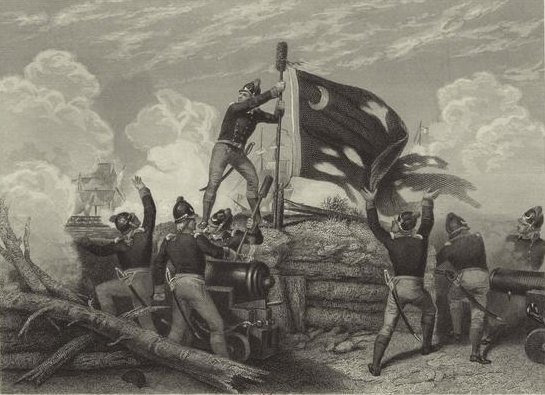
By Jeff Quinton | June 28 is Carolina Day in South Carolina. The Battle of Sullivan’s Island took place on June 28, 1776. Troops in the South Carolina Militia successfully repelled an attack from the Royal Navy on Charleston Harbor. The S.C. troops occupied an unfinished fort (Fort Sullivan, later renamed Fort Moultrie after the militia commander) made of logs from palmetto trees and the spongy nature of the wood helped repel the British cannonade. The 2nd South Carolina Regiment and the 4th South Carolina Artillery occupied the fort that day.
The painting above shows the actions of Sergeant William Jasper, who raised the regimental flag after it was shot down.
Now for, eight facts you may not know about South Carolina. I chose eight since the state was the eighth to ratify the U.S. Constitution (in 1788.)
(1) South Carolina and North Carolina originally formed a single colony called Carolina, which was owned by eight British nobleman called the Lords Proprietors. One of the proprietors, Lord Shaftesbury, drafted the Fundamental Constitutions of Carolina with the assistance of John Locke, who was his assistant. Some of the names of other proprietors can be found now as names on the map both South Carolina and North Carolina. Seven of the proprietors sold their land to the crown in 1729, which resulted in two separate colonies being formed. George II created the charter for the colony of Georgia in 1732, removing it from South Carolina territory.
(2) South Carolina’s Strom Thurmond was the first United States Senator to be elected via a write-in campaign. Thurmond was the only senator elected via write-in until Alaska’s Lisa Murkowski was re-elected via a write-in in 2010 after losing her primary.
(3) The crescent on the state flag was not intended to be a crescent moon. It was adopted from the hat devices of the 2nd SC at Fort Moultrie when Robert Barnwell Rhett designed the flag in the early days of the War Between the States. In 2007, Brian Hicks of the Post & Courier wrote a good article explaining the nuances and history of that discussion.
(4) The inventor of the maser, a precursor of the laser, was born in South Carolina. Charles Hard Townes was born in Greenville. He won the Nobel Prize for Physics in 1964 for his work. He was chairman of the NASA Science Advisory Committee during the Apollo program. He attended Furman University in Greenville for his undergraduate degree.
(5) Larry Doby, a native of Camden, was the first African-American player in the American League in Major League Baseball. Doby started playing for the Cleveland Indians shortly after (3 months later) Jackie Robinson started playing for the Brooklyn Dodgers in the National League. Doby and Satchel Paige were the first African-American players to play for a World Series champion in 1948. Doby served in the U.S. Navy in WWII and was the first player to go directly from the Negro Leagues to MLB.
(6) South Carolina is the last state to still elect its Adjutant General. All other states have an appointed Adjutant General, who serves as state commander of the National Guard. This year [2014] could be the last year that post is elected in South Carolina since an amendment is on the November ballot to make it appointed. [Editor’s note: 2014 marked the last statewide election for adjutant general following a constitutional referendum in which 56 percent of voters cast ballots to make the job appointed.]
(7) In March 1776, South Carolina elected John Rutledge as its president and Henry Laurens as vice president. This made the Palmetto State the first independent government in the colonies. The Constitution of 1788 changed those titles to Governor and Lieutenant Governor.
(8) Conservative icon Clare Boothe Luce is buried at Mepkin Abbey in Berkeley County. The land originally belonged to one of the Lords Proprietors who sold it to Henry Laurens. Henry Luce bought the plantation in 1936 and he and his wife, Clare Boothe Luce, donated part of the land to the Trappist monks who are still there back in 1949. Besides the Luce family, Henry Laurens and his son John Laurens, who was an aide-de-camp to George Washington in the Revolutionary War, are buried there.
South Carolina native and blogger Jeff Quinton now lives in the Washington, D.C., area. This 2014 piece is from his blog, The Quinton Report, and is republished with permission.



 We Can Do Better, South Carolina!
We Can Do Better, South Carolina!
























